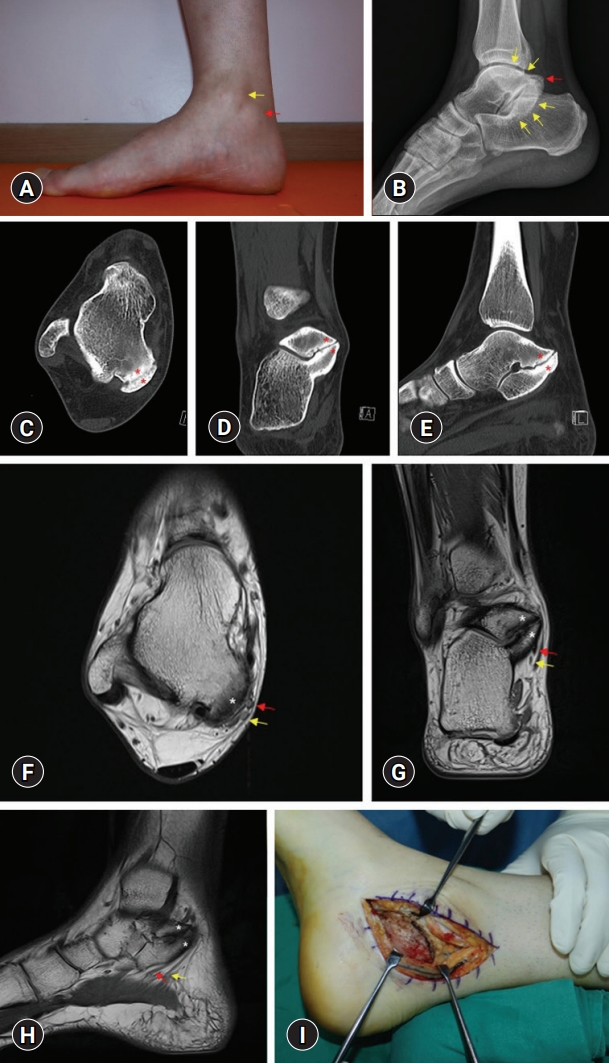PubMed Central, CAS, DOAJ, KCI

Articles
- Page Path
- HOME > J Yeungnam Med Sci > Volume 40(1); 2023 > Article
-
Image vignette
Tarsal tunnel syndrome due to talocalcaneal coalition -
Chul Hyun Park1
 , Mathieu Boudier-Revéret2
, Mathieu Boudier-Revéret2 , Min Cheol Chang3
, Min Cheol Chang3
-
Journal of Yeungnam Medical Science 2023;40(1):106-108.
DOI: https://doi.org/10.12701/yujm.2021.01473
Published online: October 5, 2021
1Department of Orthopedic Surgery, Yeungnam University College of Medicine, Daegu, Korea
2Department of Physical Medicine and Rehabilitation, Centre hospitalier de l’Université de Montréal, Montréal, Canada
3Department of Physical Medicine and Rehabilitation, Yeungnam University College of Medicine, Daegu, Korea
- Corresponding author: Min Cheol Chang, MD Department of Physical Medicine and Rehabilitation, Yeungnam University College of Medicine, 170 Hyeonchung-ro, Nam-gu, Daegu 42415, Korea Tel: +82-53-620-4682 Fax: +82-53-4231-8694 Email: wheel633@gmail.com
Copyright © 2023 Yeungnam University College of Medicine, Yeungnam University Institute of Medical Science
This is an Open Access article distributed under the terms of the Creative Commons Attribution Non-Commercial License (http://creativecommons.org/licenses/by-nc/4.0/) which permits unrestricted non-commercial use, distribution, and reproduction in any medium, provided the original work is properly cited.
-
Ethical statements
This study was approved by the Institutional Review Board of the Yeungnam University Hospital (IRB No: 2021-06-061). Written informed consent was obtained for publication of this report and accompanying images.
-
Conflicts of interest
Chul Hyun Park and Mathieu Boudier-Revéret have been editorial board member of Journal of Yeungnam Medical Science (JYMS) since 2021. Min Cheol Chang has been Associate editor of JYMS since 2021. They were not involved in the review process of this manuscript. Otherwise, there is no conflict of interest to declare.
-
Funding
This study was supported by the National Research Foundation of Korea Grant funded by the Korean Government (No. NRF2021R1A2C1013073).
-
Author contributions
Conceptualization: all authors; Investigation, Data curation: CHP, MCC; Formal analysis, Funding acquisition, Supervision: MCC; Methodology: CHP; Visualization: MB, MCC; Writing-original draft: all authors; Writing-review & editing: all authors.
Notes

- 1. Crim JR, Kjeldsberg KM. Radiographic diagnosis of tarsal coalition. AJR Am J Roentgenol 2004;182:323–8.ArticlePubMed
- 2. Cimino WR. Tarsal tunnel syndrome: review of the literature. Foot Ankle 1990;11:47–52.ArticlePubMed
- 3. Mann RA. Disease of the nerve. In: Man RA, Coughlin MJ, editors. Surgery of the foot and ankle. St. Louis: Mosby; 1999. p. 512–6.
- 4. Guduri V, Dreyer MA. Talocalcaneal coalition [updated 2021 Mar 17]. In: StatPearls [Internet]. Treasure Island (FL): StatPearls Publishing; 2021 [cited 2021 Aug 5]. https://www.ncbi.nlm.nih.gov/books/NBK549853/.
References
Figure & Data
References
Citations

- Deep-Learning Algorithms for Prescribing Insoles to Patients with Foot Pain
Jeoung Kun Kim, Yoo Jin Choo, In Sik Park, Jin-Woo Choi, Donghwi Park, Min Cheol Chang
Applied Sciences.2023; 13(4): 2208. CrossRef

 E-Submission
E-Submission Yeungnam University College of Medicine
Yeungnam University College of Medicine PubReader
PubReader ePub Link
ePub Link Cite
Cite


